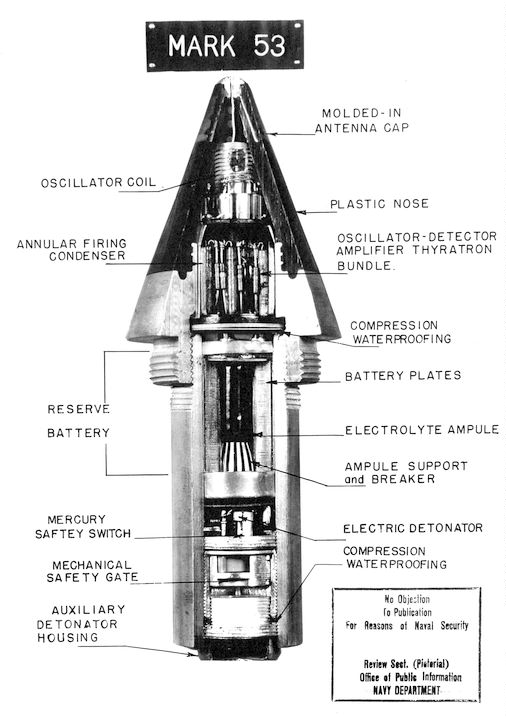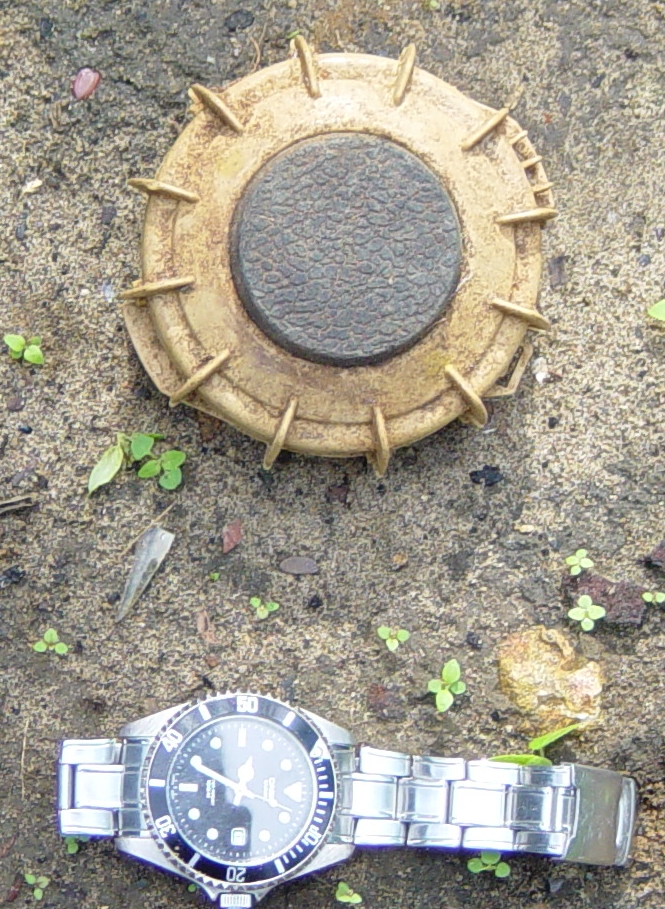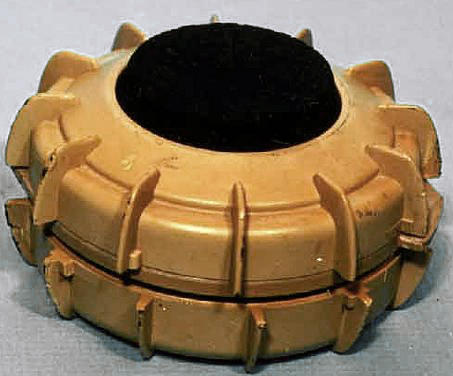|
Blast Resistant Mine
A Blast resistant mine is a landmine (intended for anti-tank or anti-personnel purposes) with a fuze which is designed to be insensitive to the shock wave from a nearby explosion. This feature makes it difficult or impossible to clear such mines using explosive minefield breaching techniques. As a result, the process of clearing minefields is slower and more complex. Blast resistance can be achieved in a number of ways. Pressure blast resistant fuzes In pressure fuzed landmines this is achieved by having the fuze react differently based on the duration of the pressure impulse. For example, a number of Italian landmines like the VS-1.6 use an air system, where air is forced through a small hole into an air bladder, the inflation of which rotates a locking collar and releases the striker into the detonator. The sudden impulse from impact or explosion does not have sufficient duration to inflate the bladder and rotate the locking collar, whereas steady pressure from a vehicle's whee ... [...More Info...] [...Related Items...] OR: [Wikipedia] [Google] [Baidu] |
Landmine
A land mine is an explosive device concealed under or on the ground and designed to destroy or disable enemy targets, ranging from combatants to vehicles and tanks, as they pass over or near it. Such a device is typically detonated automatically by way of pressure when a target steps on it or drives over it, although other detonation mechanisms are also sometimes used. A land mine may cause damage by direct blast effect, by fragments that are thrown by the blast, or by both. Landmines are typically laid throughout an area, creating a ''minefield'' which is dangerous to cross. The use of land mines is controversial because of their potential as indiscriminate weapons. They can remain dangerous many years after a conflict has ended, harming civilians and the economy. Seventy-eight countries are contaminated with land mines and 15,000–20,000 people are killed every year while many more are injured. Approximately 80% of land mine casualties are civilians, with children as the ... [...More Info...] [...Related Items...] OR: [Wikipedia] [Google] [Baidu] |
Fuze
In military munitions, a fuze (sometimes fuse) is the part of the device that initiates function. In some applications, such as torpedoes, a fuze may be identified by function as the exploder. The relative complexity of even the earliest fuze designs can be seen in cutaway diagrams. A fuze is a device that detonates a munition's explosive material under specified conditions. In addition, a fuze will have safety and arming mechanisms that protect users from premature or accidental detonation. For example, an artillery fuze's battery is activated by the high acceleration of cannon launch, and the fuze must be spinning rapidly before it will function. "Complete bore safety" can be achieved with mechanical shutters that isolate the detonator from the main charge until the shell is fired. A fuze may contain only the electronic or mechanical elements necessary to signal or actuate the detonator, but some fuzes contain a small amount of primary explosive to initiate the detonation. ... [...More Info...] [...Related Items...] OR: [Wikipedia] [Google] [Baidu] |
Shock Wave
In physics, a shock wave (also spelled shockwave), or shock, is a type of propagating disturbance that moves faster than the local speed of sound in the medium. Like an ordinary wave, a shock wave carries energy and can propagate through a medium but is characterized by an abrupt, nearly discontinuous, change in pressure, temperature, and density of the medium. For the purpose of comparison, in supersonic flows, additional increased expansion may be achieved through an expansion fan, also known as a Prandtl–Meyer expansion fan. The accompanying expansion wave may approach and eventually collide and recombine with the shock wave, creating a process of destructive interference. The sonic boom associated with the passage of a supersonic aircraft is a type of sound wave produced by constructive interference. Unlike solitons (another kind of nonlinear wave), the energy and speed of a shock wave alone dissipates relatively quickly with distance. When a shock wave passes through ... [...More Info...] [...Related Items...] OR: [Wikipedia] [Google] [Baidu] |
Valmara 69
Valmara 69 or V-69 is an Italian bounding anti-personnel mine manufactured by Valsella. The mine was developed from the V-59 mine, and although the mine is no longer produced in Italy, a number of copies were produced in other countries e.g. the "SPM-1" manufactured by Singapore. The South African version was called the J-69, and was an identical copy of the Italian version. A single centre prong version was also produced. It is no longer produced by South Africa who are compliant with the Mine Ban Treaty requirements. Description The mine has a short tubular olive green or sand colored plastic body inside which is the steel bounding body of the mine. On top of the mine is a round fuze cap with five prongs. The mine is triggered when the fuze cap tilts, either because of pressure on one of the prongs or a pull on an attached tripwire. The tilting fuze mechanism is not affected by overpressure. When the mine is triggered, a spring-loaded firing pin fires a percussion cap inside ... [...More Info...] [...Related Items...] OR: [Wikipedia] [Google] [Baidu] |
M1 Mine
The M1, M1A1 and M4 are circular steel cased United States anti-tank blast mines with a distinctive cross shaped pressure spider. The mine was used during the Second World War and a copy produced in Argentina was used during the Falklands War. Another copy is produced in China. designated the No. 4 mine. Variants of the mine have also been deployed in Chad and Tunisia. Downward pressure on the spider presses down on the head of the fuze, breaks a shear pin, and inverts a belleville spring, flipping the striker downwards into a stab sensitive detonator, triggering the mine. The M4 version of the mine has two secondary fuze wells so that anti-handling devices can be fitted. Variants * M1 – the mine has two filler plugs on the top surface. * M1A1 – the mine has a single filler plug on the top surface. * M4 – as the M1A1 but with two secondary fuze wells, one on the side and one in the bottom. Specifications *Weight: 4.80 kg *Explosive content: 2.70 kg of TNT T ... [...More Info...] [...Related Items...] OR: [Wikipedia] [Google] [Baidu] |
Minimum Metal Mine
A minimum metal mine is a land mine that is designed to use the smallest amount of metal possible in its construction. Typically, the only metal components are located inside the fuze mechanism which triggers detonation. Both minimum metal Anti-tank mine, anti-tank and anti-personnel mines exist. Some designs contain virtually no metal at all, e.g., less than a gram. This is achieved by encasing the explosive charge in a plastic, wooden, or glass body, with metallic components limited to the few small parts in the fuze which can not easily be made from other materials, such as the spring, striker tip, and shear pin. Minimum metal mines are extremely difficult to detect using conventional metal detector, metal mine detectors and usually require modern techniques, such as robotic ''Multi Period Sensing'' (MPS) equipment, to identify, but it is still extremely difficult to find non-metallic mines. These techniques are usually restricted to well-funded international mine clearing organi ... [...More Info...] [...Related Items...] OR: [Wikipedia] [Google] [Baidu] |
Anti-handling Device
An anti-handling device is an attachment to or an integral part of a landmine or other munition such as some fuze types found in general-purpose air-dropped bombs, cluster bombs and sea mines. It is designed to prevent tampering or disabling, or to target bomb disposal personnel. When the protected device is disturbed, it detonates, killing or injuring anyone within the blast area. There is a strong functional overlap of booby traps and anti-handling devices. Purpose Anti-handling devices prevent the capture and reuse of the munition by enemy forces. They also hinder bomb disposal or demining operations, both directly and by deterrence, thereby creating a much more effective hazard or barrier. Anti-handling devices greatly increase the danger of munitions to civilian populations in the areas in which they are used because their mechanisms are so easily triggered. An anti-tank mine with an anti-handling device fitted is almost guaranteed to detonate if it is lifted/overturned ... [...More Info...] [...Related Items...] OR: [Wikipedia] [Google] [Baidu] |
VS-50 Mine
The VS-50 is a circular plastic-cased anti-personnel blast mine that entered production in 1985. It was formerly made by the now-defunct Valsella Meccanotecnica SpA, an Italian high-tech defence company specialized in area denial systems. The company also the made the Valmara 69, and was one of the first to implement plastic construction for landmines. The VS-50's design is similar to that of the TS-50 and VS-MK2 mines. It is blast resistant and can be used in a minimum metal configuration. Though unlikely to kill, its explosive charge is quite sufficient to destroy the victim's foot, being capable of penetrating 5 mm of mild steel leaving an 80 mm-diameter hole. Description The mine consists of three sections, a bottom section containing the main explosive charge, a middle section which contains the fuze and safety/arming mechanism, and the top section which consists of a neoprene pressure pad. The neoprene pressure pad is sometimes reinforced with an 18 gram mild s ... [...More Info...] [...Related Items...] OR: [Wikipedia] [Google] [Baidu] |
TS-50 Mine
The TS-50 is a diameter circular Italian blast resistant minimum metal anti-personnel mine designed and produced by Valsella Meccanotecnica (Italy). Description The mine has a ribbed plastic case which is olive green, brown or sand colored. The mine has a central raised pressure pad on the top surface of the mine, but is designed to operate even with the mine upside down. Pressure on the mine forces air through a diaphragm into a small rubber air bag, which inflates. As the bag inflates it pushes a shutter, which in turn removes the striker retaining lug. The striker is free to impact the detonator. The mine requires a constant pressure of approximately 2 to 5 kg (5 to 11 lbs) for an average of 0.11 seconds before the fuze will detonate. This allows the mine to be laid in a high density pattern without the shock of a detonation impacting the nearby mines. The design of the TS-50's fuze gives it a large degree of resistance to explosive overpressure clearance techniques, be ... [...More Info...] [...Related Items...] OR: [Wikipedia] [Google] [Baidu] |
SB-33 Mine
The SB-33 is a small Italian minimum metal blast type anti-personnel mine formerly manufactured by '' Misar'', that entered service in 1977. The SB-33 can be emplaced by hand or scattered using the helicopter mounted SY-AT system. The body of the mine is made of two glass reinforced polycarbonate halves, with the top surface having a central neoprene pressure pad. The body has an irregular shape to make the mine harder to distinguish on the ground. To arm an SB-33, a small pin is removed from the side of the mine. After the mine has been armed, gradual pressure on the pressure plate (i.e. when the victim steps on it) rotates a locking collar until the striker is released, which flips into a stab-detonator and the mine explodes. However, sudden pressure (e.g. from a mine-clearing charge) causes the striker to lock the rotating collar in position for the duration of the pressure, preventing the mine from detonating. The combination of low metal content and resistance to overpressur ... [...More Info...] [...Related Items...] OR: [Wikipedia] [Google] [Baidu] |





